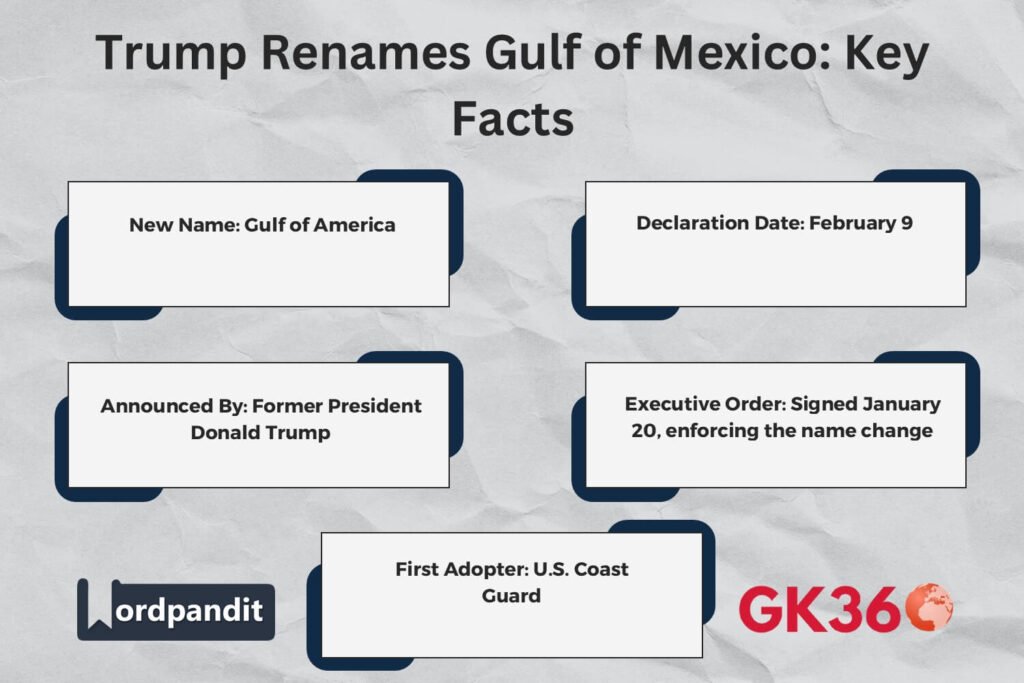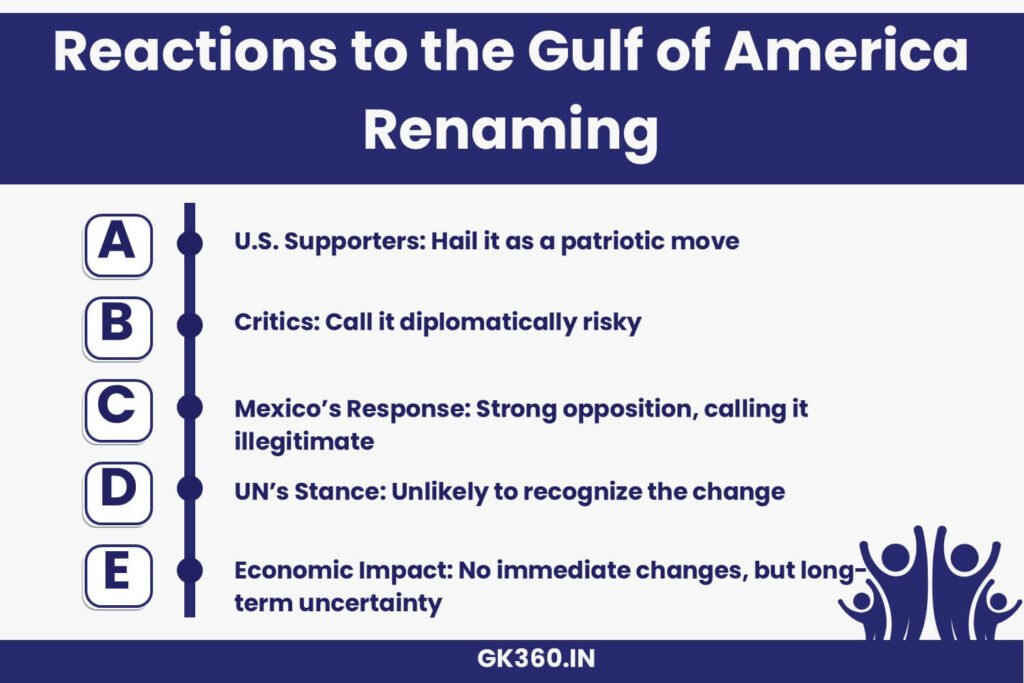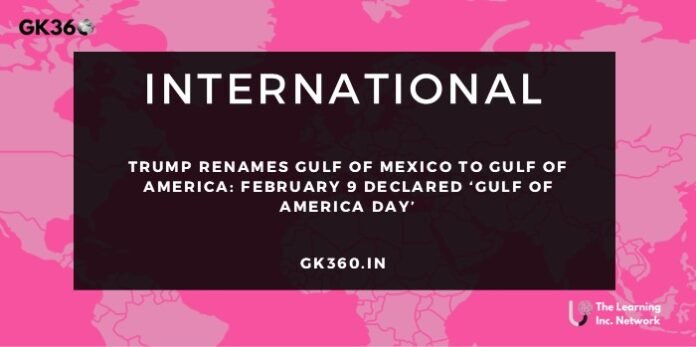Trump Renames Gulf of Mexico to Gulf of America: February 9 Declared ‘Gulf of America Day’
Introduction
In a bold and controversial move, former U.S. President Donald Trump officially renamed the Gulf of Mexico to the Gulf of America and declared February 9 as “Gulf of America Day.” This decision, announced via an executive order, has sparked intense debate both domestically and internationally.
Supporters view it as a patriotic assertion of U.S. sovereignty, while critics warn of potential diplomatic fallout. The announcement was made aboard Air Force One on February 9, as Trump flew over the newly renamed gulf en route to the Super Bowl in New Orleans.
With this move, Trump aims to reframe U.S. geographical landmarks in a way that reflects American dominance. However, questions remain about whether the international community, including the United Nations, will recognize the change.

Table of Contents
- The Executive Order: Renaming the Gulf of Mexico
- Proclamation Signed Over the Gulf of America
- US Coast Guard First to Implement the Change
- Global Reactions: Support and Controversy
- Economic and Cultural Impact
- Will the Name Change Stick?
- FAQs About the Gulf of America Renaming
- Conclusion: A Bold Move with Uncertain Consequences
The Executive Order: Renaming the Gulf of Mexico
On January 20, the day of his second inauguration, Donald Trump signed an executive order directing the Department of the Interior to rename the Gulf of Mexico to the Gulf of America. The order mandated that all federal agencies update their documentation, maps, and official records within 30 days to reflect the new designation.
Trump framed the decision as an effort to reaffirm U.S. sovereignty over key natural resources and maritime territories. While supporters argue that the renaming is a symbolic assertion of American strength, critics view it as a political move lacking international legal standing.
Proclamation Signed Over the Gulf of America
Trump signed the official proclamation mid-flight over the Gulf, making history as the first sitting U.S. president to rename a major body of water while flying over it. Speaking to reporters aboard Air Force One, he declared:
“We’re soaring over it right now, folks. It’s always been American, and today, we make it official.”
The strategic timing of the announcement—on the same day as the Super Bowl—ensured maximum publicity, with millions of Americans tuned in to witness what he called a “landmark moment in U.S. history.”
US Coast Guard First to Implement the Change
The US Coast Guard (USCG) was the first federal agency to adopt the name change, instructing personnel and official communications to begin using “Gulf of America” immediately. This move set a precedent for other agencies, including the National Oceanic and Atmospheric Administration (NOAA) and the Department of Defense (DoD), to follow suit.
However, experts point out that international organizations, including the United Nations and maritime authorities, may continue using “Gulf of Mexico,” creating a potential naming conflict on global navigation charts.
Global Reactions: Support and Controversy
Mexico and Central America Respond
Mexico strongly opposed the decision, with President Andrés Manuel López Obrador calling it “a unilateral and illegitimate act that disregards centuries of history.” The Mexican Ministry of Foreign Affairs issued a statement rejecting the name change, reaffirming that the Gulf of Mexico is a shared body of water with deep historical and geographical significance.
Will the UN Recognize the Change?
The United Nations and international maritime authorities have yet to acknowledge the renaming. Experts believe that the move is unlikely to gain global recognition since geographical names are governed by international treaties and historical precedent.
According to Professor Juan Ortega, a maritime law expert:
“The United States can call it the Gulf of America domestically, but international navigation charts and treaties will continue to recognize it as the Gulf of Mexico.”
Economic and Cultural Impact
The Gulf of America (formerly Gulf of Mexico) is a vital economic region for the U.S., supporting key industries:
🔹 Oil & Gas Industry
- The Gulf supplies a significant portion of U.S. energy needs, with major offshore drilling operations.
🔹 Fishing & Seafood
- The region is one of the world’s most productive fisheries, supporting thousands of jobs.
🔹 Tourism & Real Estate
- Coastal states like Texas, Louisiana, Mississippi, Alabama, and Florida thrive on beach tourism and real estate investments.
While Trump’s administration argues that the renaming reinforces economic significance, critics question whether the change will have any real impact beyond symbolism.
Will the Name Change Stick?
The long-term adoption of “Gulf of America” depends on several factors:
🔹 Government Endorsement
- If more federal and state agencies adopt the term, it will gain domestic traction.
🔹 Public Adoption
- If the media, schools, and businesses start using the name, it could gradually become normalized.
🔹 International Recognition
- Without global acknowledgment, the name might remain a U.S.-centric designation.
For now, while the renaming has attracted nationwide attention, whether it becomes an accepted part of American geography remains uncertain.

FAQs About the Gulf of America Renaming
1️⃣ Can the U.S. legally rename the Gulf of Mexico?
✅ The U.S. can refer to the body of water as the Gulf of America domestically, but international recognition requires approval from organizations like the UN and the International Hydrographic Organization (IHO).
2️⃣ How does the renaming affect international treaties?
✅ Most treaties refer to the gulf as the Gulf of Mexico, meaning this change has no legal effect on international agreements.
3️⃣ Will maps and GPS systems update to show “Gulf of America”?
✅ U.S.-based mapping services (e.g., Google Maps, government agencies) might adopt the name, but international maps will likely retain “Gulf of Mexico.”
4️⃣ How does this impact Mexico and Central American nations?
✅ Mexico has rejected the name change, and Central American nations have expressed concerns about the implications of unilateral territorial renaming.
5️⃣ What is the significance of February 9 as ‘Gulf of America Day’?
✅ Trump chose February 9 to coincide with the Super Bowl, ensuring maximum public attention and media coverage.
Conclusion: A Bold Move with Uncertain Consequences
Trump’s renaming of the Gulf of Mexico to the Gulf of America and his declaration of February 9 as Gulf of America Day marks one of the most controversial geopolitical moves of his administration.
While it resonates with his base as a symbol of American sovereignty, it raises significant questions about international legitimacy and diplomatic repercussions.
Key Takeaways
| Aspect | Details |
|---|---|
| Renaming Decision | Trump signed an executive order renaming the Gulf of Mexico to the Gulf of America. |
| First Implementation | The U.S. Coast Guard was the first federal agency to enforce the change. |
| Mexico’s Opposition | Mexico rejects the name change, citing historical and legal reasons. |
| Global Recognition | The UN and international bodies are unlikely to acknowledge the change. |
| Economic Impact | The change has symbolic importance but little immediate economic effect. |
| Public Adoption | The name’s success depends on whether media, businesses, and agencies use it. |
| Gulf of America Day | February 9 was declared as an annual observance to mark the renaming. |
Related Terms:
- Trump Gulf of America
- Gulf of Mexico name change
- Gulf of America controversy
- February 9 Gulf of America Day
- Trump renames Gulf of Mexico
- U.S. sovereignty Gulf of America
- Mexico reaction Gulf of America
- UN response to Gulf of America
- Economic impact of Gulf renaming
- Trump executive order Gulf renaming





